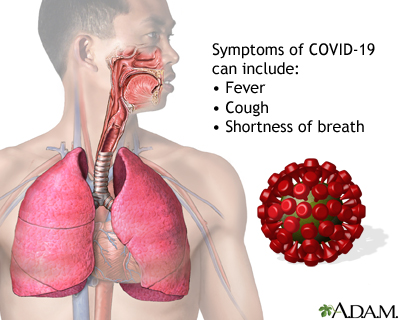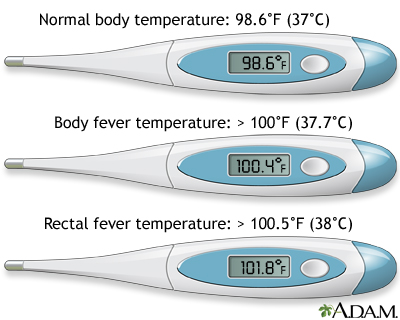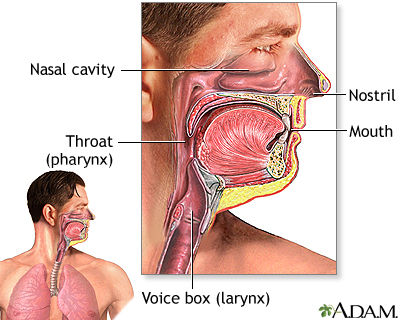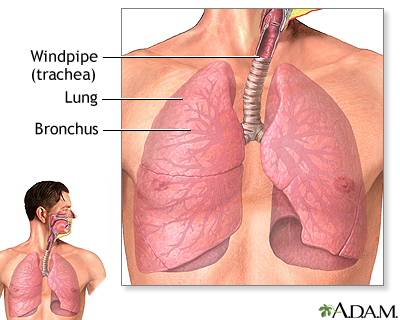COVID-19 symptoms
Coronavirus novel 2019 - symptoms; 2019 Novel coronavirus - symptoms; SARS-Co-V2 - symptoms
COVID-19 is a highly infectious respiratory illness caused by a virus called SARS-CoV-2.
COVID-19 symptoms can range from mild to severe. Symptoms may include:
- Fever
- Chills
- Cough
- Coughing up blood (hemoptysis)
- Shortness of breath or difficulty breathing
- Fatigue
- Muscle aches
- Headache
- Loss of sense of taste or smell
- Sore throat
- Stuffy or runny nose
- Nausea and vomiting
- Diarrhea
This is not a complete list of possible symptoms. Symptoms may change with new variants of the virus.
Some people may have no symptoms at all. Many have only some, but not all of the symptoms. Symptoms can also vary, depending on whether you are vaccinated.
Symptoms may develop within 2 to 14 days after you are exposed to the virus. Most often, symptoms appear around 5 days after exposure. However, you can spread the virus even when you do not have symptoms.
More severe symptoms that require seeking medical help right away include:
- Trouble breathing
- Chest pain or pressure that persists
- Confusion
- Inability to wake up
- Blue, gray, or pale skin, lips, face, or nail beds (cyanosis), depending on your skin tone
Older people and people with certain existing health conditions have a higher risk of developing severe illness and death. Health conditions that increase your risk include cancer, COPD, diabetes, heart disease and stroke, a weak immune system (immunocompromised), and many others.

Coughing is a sudden expulsion of air from the lungs through the epiglottis, cartilage located in the throat, at an amazingly fast speed. Compared to a tennis ball hit at 50 miles per hour, or a baseball at 85 miles per hour...coughing is faster, with an estimated speed of 100 miles per hour. With such a strong force of air, coughing is the body's mechanism for clearing the breathing passageways of unwanted irritants. Let's take a look at the vocal cords prior to a cough. In order for a cough to occur, several events need to take place in sequence. Let's use the unwanted irritant of water entering the windpipe, also known the trachea, to trigger the coughing reflex. First, the vocal cords open widely allowing additional air to pass through into the lungs. Then the epiglottis closes off the windpipe, and simultaneously, the abdominal and rib muscles contract, increasing the pressure behind the epiglottis. With the increased pressure, the air is forcefully expelled, and creates a rushing sound as it moves very quickly past the vocal cords. The rushing air dislodges the irritant making it possible to breathe comfortably again.

Infection with severe acute respiratory syndrome coronavirus 2 (SARS-CoV-2) causes COVID-19, a respiratory illness that ranges from mild symptoms to pneumonia or even death. Symptoms occur within 2 to 14 days from exposure to the virus and may include fever, cough, shortness of breath, chills, muscle pain, headache, sore throat, and new loss of sense of taste or smell. COVID-19 may be more severe in people who are older or who have chronic health conditions, such as heart disease or diabetes.

Fever is an important part of the body's defense against infection. Most bacteria and viruses that cause infections in humans thrive best at 98.6 degrees F (37 degrees C). Raising the body temperature a few degrees can help the body fight the infection. In addition, a fever activates the body's immune system to make more white blood cells, antibodies, and other infection-fighting agents.

Air is breathed in through the nasal passageways, travels through the trachea and bronchi to the lungs.

The major passages and structures of the upper respiratory tract include the nose or nostrils, nasal cavity, mouth, throat (pharynx), and voice box (larynx). The respiratory system is lined with a mucous membrane that secretes mucus. The mucus traps smaller particles like pollen or smoke. Hairlike structures called cilia line the mucous membrane and move the particles trapped in the mucus out of the nose. Inhaled air is moistened, warmed, and cleansed by the tissue that lines the nasal cavity.

The major passages and structures of the lower respiratory tract include the windpipe (trachea) and within the lungs, the bronchi, bronchioles, and alveoli. Deep in the lungs, each bronchus divides into secondary and tertiary bronchi, which continue to branch to smaller airways called the bronchioles. The bronchioles end in air sacs called the alveoli. Alveoli are bunched together into clusters to form alveolar sacs. Gas exchange occurs on the surface of each alveolus by a network of capillaries carrying blood that has come through veins from other parts of the body.
Considerations
Some symptoms of COVID-19 are similar to those of the common cold and the flu, so it can be hard to know for sure if you have the SARS-CoV-2 virus. But COVID-19 is not a cold, and it is not a flu.
The only way to know if you have COVID-19 is to be tested. If you want to be tested, you should contact your health care provider or use a home diagnostic test.
Most people with the illness have mild to moderate symptoms and recover fully. Whether you get tested or not, if you have symptoms of COVID-19, you should avoid contact with other people so you don't spread the illness.
Causes
COVID-19 is caused by the SARS-CoV-2 virus (severe acute respiratory syndrome coronavirus 2). Coronaviruses are a family of viruses that can affect people and animals. They can cause mild to severe respiratory illnesses.
COVID-19 spreads to people within close contact (about 6 feet or 2 meters). When someone with the illness coughs or sneezes, infectious droplets spray into the air. You can catch the illness if you breathe in or touch these particles and then touch your face, nose, mouth, or eyes.
Home Care
If you have COVID-19 or think you have it, stay at home and avoid contact with other people, both inside and outside your home, to avoid spreading the illness. You should do this right away and not wait for any COVID-19 testing.
To help treat the symptoms of COVID-19, the following tips may help.
- Rest and drink plenty of fluids.
- Acetaminophen (Tylenol) and ibuprofen (Advil, Motrin) help reduce fever. Sometimes, providers advise you to use both types of medicine. Take the recommended amount to reduce fever. Do not use ibuprofen in children 6 months or younger.
- A lukewarm bath or sponge bath may help cool a fever. Keep taking medicine -- otherwise your temperature might go back up.
- If you have a dry, tickling cough, try cough drops or hard candy.
- Use a vaporizer or take a steamy shower to increase moisture in the air and help soothe a dry throat and cough.
- Do not smoke, and stay away from secondhand smoke.
When to Contact a Medical Professional
You should contact your provider right away:
- If you have symptoms and think you may have COVID-19
- If you have COVID-19 and you are in a group for whom antiviral medicine may be given
- If you have COVID-19 and your symptoms are getting worse
Call 911 or the local emergency number if you have:
- Trouble breathing
- Chest pain or pressure that persists
- Confusion or inability to wake up
- Blue, gray, or pale skin, lips, face, or nail beds (cyanosis)
- Any other symptoms that are severe or that concern you
What to Expect at Your Office Visit
Your provider will ask about your symptoms, any recent travel, and any possible exposure to COVID-19. Your provider may take swab samples from the back of your nose and throat.
If your symptoms do not indicate a medical emergency, you can recover at home.
For more serious symptoms, you may need to go to the hospital for care.
References
Centers for Disease Control and Prevention website. COVID-19: testing for COVID-19.
Centers for Disease Control and Prevention website. COVID-19: types of COVID-19 treatment.
Centers for Disease Control and Prevention website. Respiratory illnesses: respiratory virus guidance.
Centers for Disease Control and Prevention website. COVID-19: symptoms of COVID-19.
Del Rio C, Gandhi M, Cohen MS. COVID-19: epidemiology, clinical manifestations, diagnosis, and community prevention. In: Goldman L, Cooney KA, eds. Goldman-Cecil Medicine. 27th ed. Philadelphia, PA: Elsevier; 2024:chap 336.
Version Info
Last reviewed on: 1/1/2025
Reviewed by: Linda J. Vorvick, MD, Clinical Professor Emeritus, Department of Family Medicine, UW Medicine, School of Medicine, University of Washington, Seattle, WA. Also reviewed by David C. Dugdale, MD, Medical Director, Brenda Conaway, Editorial Director, and the A.D.A.M. Editorial team. Editorial update 06/05/2025.
